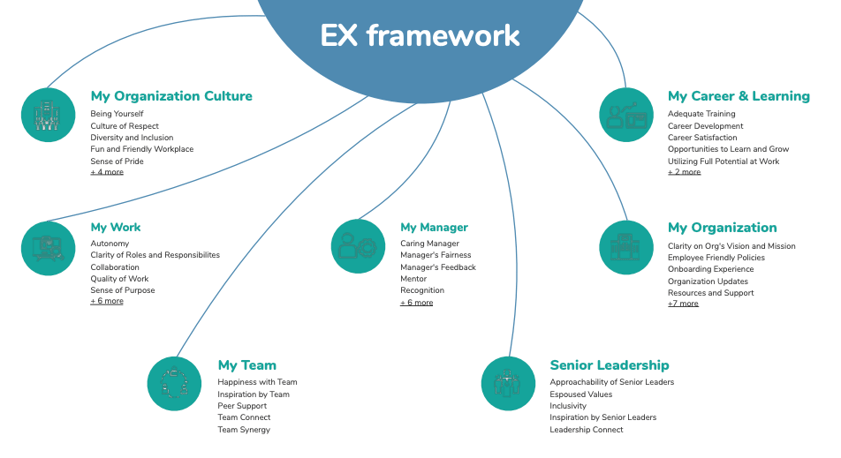Engage with personalized listening & AI
Engage top talent before they join.
Connect with alumni, build brand advocates
Listen contextually & predict turnover
Automate HR services with Agentic AI
Run targeted/broad communication campaigns
Turn people analytics to business outcomes
Explore how HR leaders use Amber
Your go-to content hub for all things people.
4 min read
Ajay Ruhela
Last Updated: 21 February 2023
“Having a great sales team is a much stronger (and far lasting) competitive advantage than having a great product.” That's Neil Rackham, a pioneer in “consultative selling” and author of SPIN selling, in a London conference. He went on to explain why good, innovative products fail to take off.
Being a researcher in employee experience, I was drawn to the parallel within the organizational space where an effective HR strategic business partner can be a stronger, far-lasting competitive advantage than the actual people practice.
Let me break this down with an analogy close to my heart.
Think of the different HR roles as the council of Jedis (Star Wars alert!). The Jedi council is responsible for harmony in the galaxy. They assess risks, establish order, take preventive measures and do course corrections to fight Death Stars, Darth Vader, and Ewoks (really? not really.).
The HR structure is very similar — Strategic HR (the Jedi Council) and Operational HR (the Jedis). The HR strategic business partners are the glue that holds these two structures together (essentially Obi-Wan). They are responsible for harmony in the organizational ecosystem.
And they...
While at a high-level, this sounds great and dandy, the amount of stakeholders HR has to tap on to build personalized employee experience is a lot. Here’s a stakeholder matrix the People Science team at inFeedo keeps a close eye on for experience management of an employee in an organization:

It’s difficult to get relevant data and insights to stay focussed on experience delivery (we use Amber for our real-time talent insights). Even with the right insights, creating experience harmony is the step that is hard to get a grip on (the experience elements being both tangible and intangible).
If you’re looking for a wormhole wherein lies a heightened employee experience, I suggest you save that space travel for some other adventure. Here are the three things that can really help build contentment and commitment (while we continue to evolve our people practices, the famed strategy diadem):
Believe you should. I call this E3 strategy: Employee Experience Enhancement. Use it to sell internally if you need to...from one HR to another (before I call my lawyer and get it trademarked) :)
Well, here you go.
An outcome of the Google's famous study, Project Aristotle, set out to help the organization codify the secrets to team effectiveness. There were 5 factors associated with an enhanced team. The 5th factor stood out from the rest.
Yes you’re right. It’s Psychological Safety.
This concept has been around since the 60s and is the most studied enabling condition in group dynamics and team learning research. This relates to an employee’s perception on how threatening or rewarding it is to take interpersonal risks at work.

A psychologically safe work environment improves:
To do a ground assessment for psychological safety in teams, here are some observable behavior to look out for (through tools, portals or conversations):
HR can help build this factor in team micro-cultures and organization culture as a whole. The important stakeholders to drive this are the manager and leadership.
Here’s a quick guide with steps to build PS in the workplace. Use these steps for your manager training programs, especially for first-time managers.
The story goes like this. President John F. Kennedy was visiting NASA headquarters for the first time in 1961, the US and USSR were in a space race. While touring the facility, he introduced himself to a janitor who was mopping the floor and asked him what he did at NASA.
“I’m helping put a man on the moon!” — The janitor
The janitor got it. He understood the vision, his part in it, and he had purpose. That’s meaning amplification at work. Organization vision, mission, and strategy is the trinity a leader needs to leverage to amplify meaning at work and HR strategic partner's role is to translate these three to create:
for the employees when they do job evaluation, org structuring, and competency designs. These factors need to be reinforced time and again through internal communication (think outbound connect for Sales). Stakeholders who drive meaning amplification are managers and leadership while HR facilitates and create structures to reinforce the organizational trinity.
When employees fail to connect their work to the larger enterprise cause, the psychological contract takes a hit.

The academic way to explain this would be sustained commitments between employees wherein they feel a sense of belonging through trusted and supportive interpersonal relationships and the ability to freely vent without the fear of consequences.
The easy way to understand this is creating voice vents like we have air vents in a building. Without an air vent, you’d feel suffocated and want to go out for a breather. Without a voice vent, an employee would want to finish work and immediately walk-out. A voice vent for an employee could be her
Paired with the right set of people practices, these three constructs can help steer an organization to be a star organization (not a Star Wars reference at all) where people continually expand their capacity to create the results they truly desire, where new and expansive patterns of thinking are nurtured, where collective aspiration is set free, and where people are continually learning to see the whole together. That’s actually learning organizations defined by Peter Block. More on that later.
Before I sign-off, I got one last thing to say.

See why global HR teams rely on Amber to listen, act, and retain their best people.